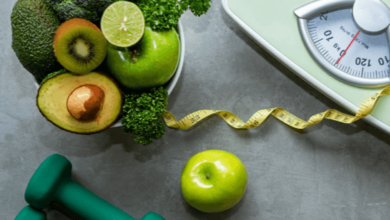Top Dietitian-Approved Recipes for Health

When it comes to maintaining a healthy lifestyle, the food you eat plays a crucial role. Incorporating nutritious and balanced meals into your diet not only supports overall well-being but also helps prevent chronic diseases, boosts energy levels, and improves mood. However, finding recipes that are both delicious and dietitian-approved can sometimes be challenging. In this guide, we’ve compiled a selection of top dietitian-approved recipes that are packed with essential nutrients, easy to prepare, and sure to satisfy your taste buds.
Breakfast: Energizing Start to Your Day
Breakfast is often considered the most important meal of the day, setting the tone for your energy levels and metabolism. Dietitians recommend starting the day with a meal that includes a balance of complex carbohydrates, protein, and healthy fats. This combination helps to stabilize blood sugar levels and keep you full until your next meal.
One highly recommended breakfast option is Overnight Oats with Chia Seeds and Berries. This recipe is rich in fiber, antioxidants, and omega-3 fatty acids, making it an ideal choice for a healthy start. To prepare, combine rolled oats, chia seeds, and your choice of milk (such as almond, soy, or dairy) in a jar. Add a handful of mixed berries and a drizzle of honey for natural sweetness. Seal the jar and refrigerate overnight. In the morning, you’ll have a delicious, ready-to-eat breakfast that requires no cooking.
Another excellent breakfast option is Greek Yogurt Parfait with Nuts and Fresh Fruit. Greek yogurt is high in protein, which is essential for muscle repair and growth, while nuts provide healthy fats and fiber. To make this parfait, layer Greek yogurt with slices of fresh fruit like bananas, strawberries, or blueberries. Top with a sprinkle of your favorite nuts, such as almonds or walnuts, and add a spoonful of honey or a dash of cinnamon for extra flavor.
Lunch: Nourishing Midday Meals
A well-balanced lunch is key to maintaining energy levels throughout the day. It’s important to include a variety of vegetables, lean proteins, and whole grains in your midday meal. These components provide essential nutrients that help keep you focused and satisfied until dinner.
A popular dietitian-approved lunch recipe is Quinoa Salad with Grilled Chicken and Vegetables. Quinoa is a complete protein, meaning it contains all nine essential amino acids, making it a great base for a nutritious meal. To prepare this salad, cook quinoa according to package instructions and let it cool. Grill a chicken breast seasoned with your favorite herbs and spices, then slice it into thin strips. In a large bowl, combine the cooked quinoa, grilled chicken, and a variety of chopped vegetables, such as cucumbers, bell peppers, and cherry tomatoes. Toss with a simple dressing made of olive oil, lemon juice, and a pinch of salt and pepper.
For a plant-based lunch option, consider Lentil and Spinach Soup. Lentils are an excellent source of plant-based protein and fiber, while spinach is rich in iron and other essential vitamins. To make this soup, sauté diced onions, carrots, and celery in olive oil until softened. Add minced garlic, dried thyme, and bay leaves, and cook for another minute. Stir in rinsed lentils, vegetable broth, and a can of diced tomatoes. Bring to a boil, then reduce heat and simmer until the lentils are tender. Just before serving, stir in fresh spinach leaves until wilted. This hearty soup is both filling and nourishing.
Dinner: Balanced and Satisfying Meals
Dinner should be a balanced meal that includes lean proteins, whole grains, and a variety of vegetables. This combination not only supports muscle recovery and repair but also provides the necessary nutrients to wind down and prepare for a restful night’s sleep.
A dietitian favorite for dinner is Baked Salmon with Asparagus and Brown Rice. Salmon is rich in omega-3 fatty acids, which are beneficial for heart health, while asparagus provides fiber, vitamins, and minerals. To prepare this dish, season salmon fillets with olive oil, lemon juice, garlic, and fresh dill. Place the fillets on a baking sheet lined with parchment paper, alongside trimmed asparagus spears. Bake in a preheated oven at 375°F (190°C) for about 15-20 minutes, or until the salmon flakes easily with a fork. Serve the salmon and asparagus with a side of cooked brown rice for a complete and satisfying meal.
Another dinner option that’s both flavorful and nutritious is Stuffed Bell Peppers with Ground Turkey and Quinoa. Bell peppers are high in vitamin C and provide a sweet, crunchy base for this dish. To make stuffed peppers, cut the tops off of the bell peppers and remove the seeds. In a skillet, sauté ground turkey with diced onions, garlic, and your favorite seasonings until fully cooked. Stir in cooked quinoa and a can of diced tomatoes, and season with salt and pepper. Stuff the mixture into the bell peppers and place them in a baking dish. Cover with foil and bake at 350°F (175°C) for 25-30 minutes, or until the peppers are tender.
Snacks: Healthy Bites Between Meals
Snacking can be a part of a healthy diet if you choose nutrient-dense options that satisfy hunger without adding unnecessary calories. Dietitian-approved snacks are typically high in fiber and protein, which help to keep you full and energized between meals.
One excellent snack choice is Hummus with Fresh Vegetables. Hummus, made from chickpeas, is high in protein and fiber, making it a filling and nutritious dip. Pair it with an assortment of fresh vegetables, such as carrot sticks, cucumber slices, and bell pepper strips. This combination provides a satisfying crunch and a boost of vitamins and minerals.
Another simple and healthy snack is Apple Slices with Almond Butter. Apples are rich in dietary fiber and vitamin C, while almond butter provides healthy fats and protein. To prepare, simply slice an apple and spread a thin layer of almond butter on each slice. This snack is sweet, satisfying, and packed with nutrients.
Desserts: Indulgent Yet Nutritious Treats
Even when focusing on healthy eating, there’s room for the occasional treat. Dietitian-approved desserts often include natural sweeteners, whole grains, and fruits to satisfy your sweet tooth without compromising your health goals.
One popular dessert option is Chia Seed Pudding with Fresh Fruit. Chia seeds are high in omega-3 fatty acids, fiber, and protein, making them a nutritious base for a healthy dessert. To make chia seed pudding, mix chia seeds with your choice of milk and a splash of vanilla extract. Stir in a natural sweetener like maple syrup or honey, and let the mixture sit in the refrigerator for a few hours or overnight until it thickens to a pudding-like consistency. Top with fresh fruit, such as berries or sliced kiwi, before serving.
Another delicious and healthy dessert is Baked Apples with Cinnamon and Walnuts. Apples are naturally sweet and high in fiber, while walnuts provide a dose of healthy fats. To prepare this dessert, core apples and place them in a baking dish. Fill the center of each apple with a mixture of chopped walnuts, cinnamon, and a drizzle of honey. Bake at 350°F (175°C) for about 20-25 minutes, or until the apples are tender. This warm, comforting dessert is perfect for satisfying your sweet cravings in a healthy way.
Incorporating Variety and Balance
One of the key principles dietitians emphasize is the importance of variety and balance in your diet. No single food can provide all the nutrients your body needs, so it’s essential to include a wide range of foods from all the major food groups. The recipes mentioned in this guide offer a diverse selection of meals that incorporate vegetables, fruits, whole grains, lean proteins, and healthy fats, ensuring you get a broad spectrum of nutrients.
In addition to variety, portion control is also important. Even healthy foods can contribute to weight gain if consumed in excessive amounts. Dietitians recommend paying attention to portion sizes and listening to your body’s hunger and fullness cues to avoid overeating.
Meal Planning and Preparation
Meal planning and preparation are vital strategies for maintaining a healthy diet. By planning your meals ahead of time, you can ensure that your diet is balanced and aligned with your health goals. This also helps you avoid the temptation of unhealthy convenience foods when you’re short on time.
Start by creating a weekly meal plan that includes a variety of dietitian-approved recipes. Make a shopping list based on the ingredients you’ll need, and consider batch cooking some meals in advance to save time during the week. For example, you can prepare a large batch of quinoa or brown rice and use it in multiple meals, such as salads, bowls, and side dishes. Similarly, cooking extra portions of protein, like grilled chicken or roasted vegetables, can be stored in the refrigerator and used throughout the week.
Staying Hydrated
In addition to focusing on food, staying hydrated is essential for overall health. Water is the best choice for hydration, but you can also include other healthy beverages like herbal teas, infused water, or low-sugar smoothies. Avoid sugary drinks and excessive amounts of caffeine, as they can contribute to dehydration and provide empty calories.
If you’re looking for a refreshing and hydrating beverage, try Cucumber Mint Infused Water. Simply add slices of cucumber and fresh mint leaves to a pitcher of water and let it chill in the refrigerator for a few hours. This infused water is not only hydrating but also offers a mild, refreshing flavor without any added sugars or artificial ingredients.
Embracing a Healthy Lifestyle
Eating dietitian-approved recipes is a significant step towards better health, but it’s also important to adopt a holistic approach to wellness. This includes regular physical activity, adequate sleep, stress management, and mindful eating practices.
Engage in regular exercise that you enjoy, whether it’s walking, cycling, swimming, or yoga. Physical activity complements a healthy diet by supporting weight management, improving cardiovascular health, and boosting mood.
Sleep is another crucial factor in maintaining health. Aim for 7-9 hours of quality sleep each night to support your body’s recovery processes and regulate appetite hormones.
Managing stress is also vital, as chronic stress can lead to unhealthy eating habits and negatively impact your overall well-being. Practice stress-relief techniques such as deep breathing, meditation, or spending time in nature to help manage stress levels.
Finally, practice mindful eating by paying attention to the taste, texture, and aroma of your food. This helps you enjoy your meals more fully and prevents overeating by encouraging you to eat slowly and savor each bite.
Conclusion
Incorporating these dietitian-approved recipes into your daily routine can help you achieve and maintain a healthy, balanced diet. By focusing on nutrient-dense foods that are both delicious and satisfying, you can support your overall health, prevent chronic diseases, and enjoy a variety of flavors and textures. Remember that a healthy lifestyle is about balance, variety, and enjoying the foods you love in moderation. Whether you’re preparing breakfast, lunch, dinner, or snacks, these recipes offer a solid foundation for nourishing your body and supporting long-term wellness.





